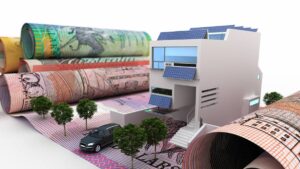Think Big: Why the inflation story is ‘very much one to watch’ in 2021

Pic: d3sign / Moment via Getty Images
Regular readers would know the Think Big desk enjoys a bit of inflation chatter.
And in some research earlier this week, CBA economist Gareth Aird weighed in on Australia’s 2021 inflation outlook.
As an economic metric, inflation has a key influence on the outlook for interest rates.
In the wake of the pandemic, central banks globally shifted gears on how monetary policy will be conducted.
Instead of basing interest rates on what they think inflation will be, they said rates won’t rise until actual inflation climbs sustainably above the generally accepted 2 per cent growth rate.
Two per cent inflation is unlikely to be a near-term reality in Australia.
But analysing a confluence of factors, Aird said this year’s inflation story is “very much one to watch”.
Up or down?
Inflation has lots of inputs (87 to be precise) and moving parts, so Aird framed his analysis by making the case for lower and higher inflation.
The case for low inflation starts with low wages, which are expected to remain anchored over the medium-term due to spare capacity in the labour market.
In addition, CBA expects strong commodity prices (hello iron ore) to keep the Aussie dollar supported near US80c, which will help cap import inflation.
But on the flipside, Aird isn’t ruling out the chance that Australia’s post-COVID economic recovery may get the inflation beast…if not waking up, then at least stirring in its sleep.
For starters, Australian households are cashed up. In pre-Christmas research, CBA estimated that domestic households have saved an extra $100bn during the pandemic.
Basing inflation forecasts off demand-side factors is a tricky exercise, but Aird ran some models anyway.
As it turns out there’s “a pretty close relationship historically between growth in household disposable income and consumer price inflation”.
With households across the country severely constricted in what they can do, Aird said their increased purchasing power “has not been fully realised”.
Domestic consumer confidence at 10-year highs, and it’s reasonable to expect that some of these savings will be spent as the economy recovers.
With increased demand, it’s likely that inflation will also rise. In fact, it’s already happening.
Prices for “furniture, textiles, major household appliances and small electrical appliances have all risen very sharply” since the March quarter last year, Aird said.
The question is, will these increases be enough to drive increases across the broader inflation basket?
Collectively, Aird said the components he flagged where prices are rising account for around 40 per cent of the basket.
Conversely, residential property rents — a core component of the broader housing category — are expected to fall this year.
“So as always there will be a variety of forces that are influencing price outcomes,” Aird said.
Market reaction
In forming his own forecast, Aird observed that in the decade-plus since the financial crisis, markets have become very accustomed to low inflation.
And right now, “nominal bond yields imply low inflation is here forever”.
Markets are also operating off the most recent round of guidance from the Reserve Bank (RBA), which has been fairly direct.
As of December, the RBA said it doesn’t expect to increase the cash rate for “at least three years”.
In its most recent set of forecasts, the bank also flagged a trimmed-mean inflation print of just one per cent by the end of 2021.
Which means that if there is an unexpected rise in inflation, things may get a little “edgy” — particularly in the bond market.
“We think there is a clear risk of that happening in 2021, even with the economy operating with an output gap,” Aird said.
CBA now expects trimmed-mean inflation to rise to 1.7pc by year-end. That’s still low, but the risks are “to the upside”.
If the economy gets “clear air” in the second half of this year — no border closures or distancing restrictions — Aird said his inflation forecast is likely to rise.
Adding it all up, the pace of Australia’s economic rebound leaves the policy mix at an interesting juncture.
Rates are at rock bottom and are expected to stay there.
Aird also expects the RBA to extend its bond-buying program when the first $100bn round ends in April. And don’t forget the yield-curve control program on three-year government bonds.
That combination — a rebounding economy combined with ultra-supportive monetary policy settings — may leave markets with a tricky morsel to digest.
As Aird describes it, the “competing forces of more RBA bond buying against some upside inflation surprises”.
The RBA will hold its first 2021 meeting February 2, followed by its latest round of forecasts on February 5.
Aird said the RBA is unlikely to change its forecasts around inflation or interest rates next month.
But he expects to see some modest upward revisions “as the economic data leaves them with little choice.”
And it sets the stage for possible fall-out scenarios in the wake of the post-COVID policy response.
“Put another way, ongoing big fiscal deficits funded via the printing press which boosts the money supply, could be a recipe for higher inflation,” Aird said.
UNLOCK INSIGHTS
Discover the untold stories of emerging ASX stocks.
Daily news and expert analysis, it's free to subscribe.
By proceeding, you confirm you understand that we handle personal information in accordance with our Privacy Policy.








